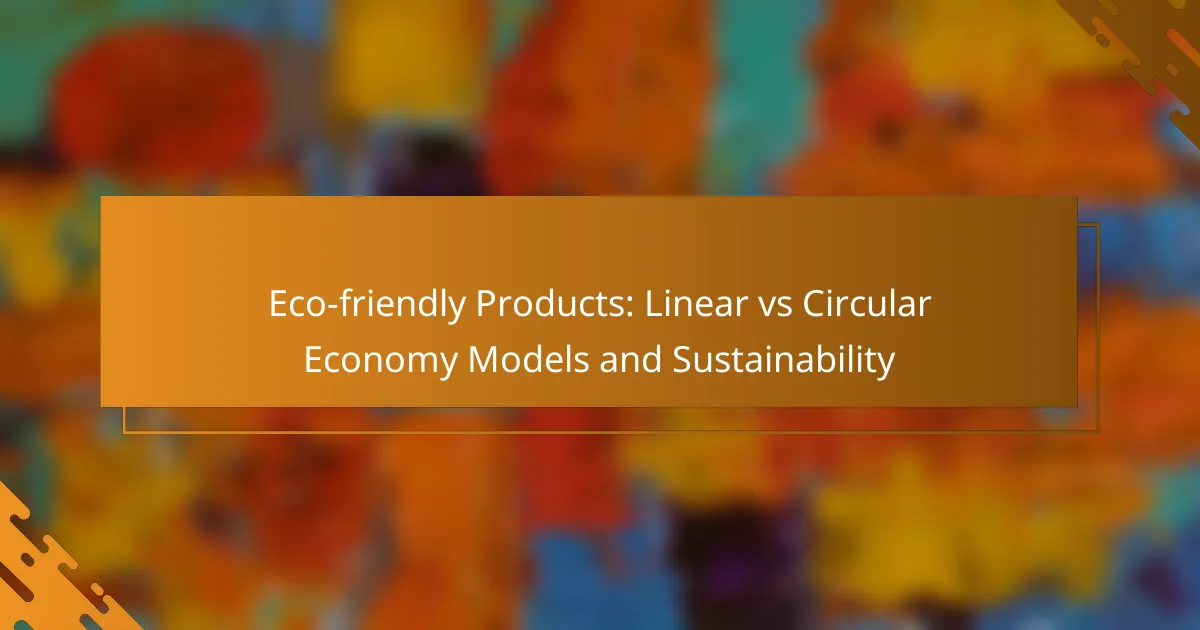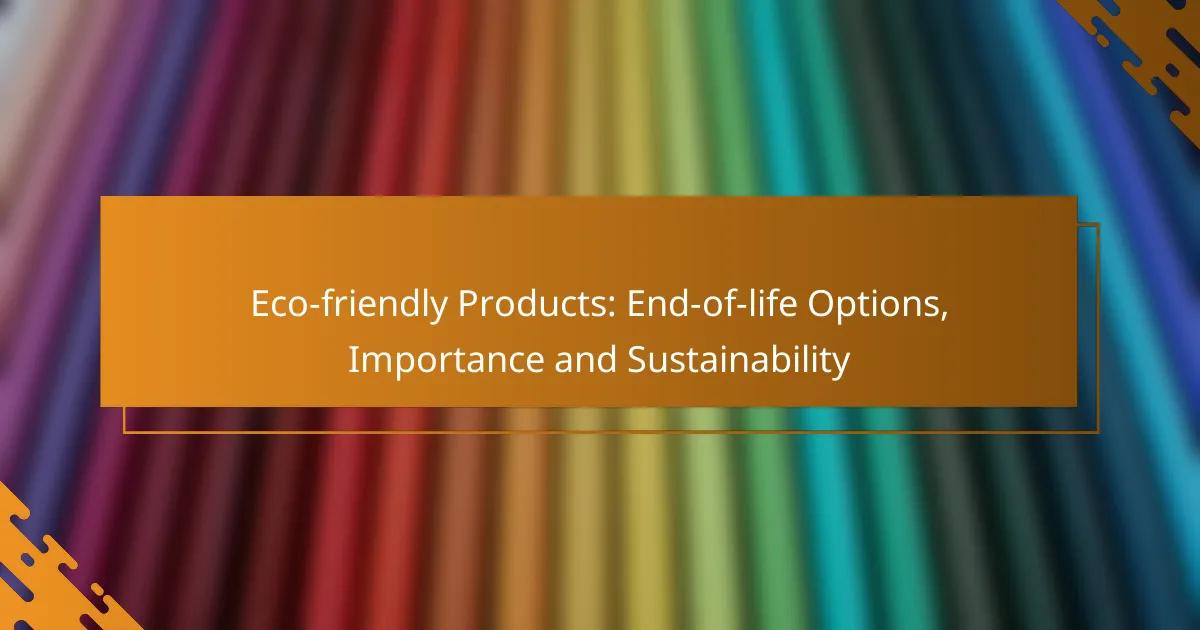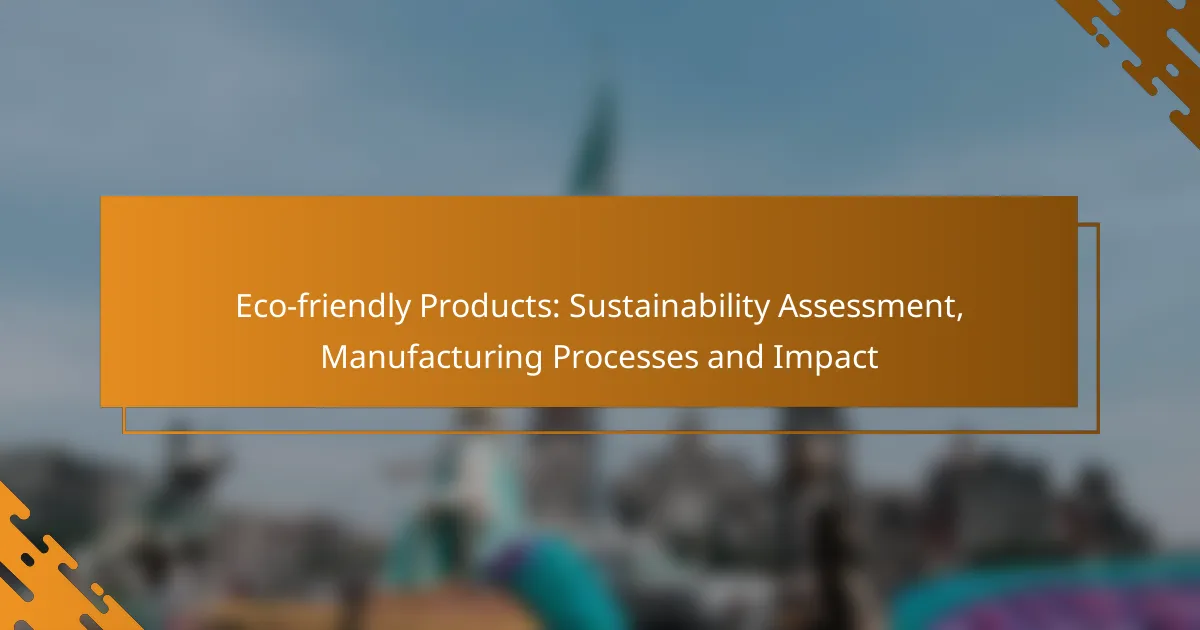Eco-friendly products are essential in promoting sustainability within a circular economy, as they are designed to minimize waste and maximize resource efficiency. By prioritizing reuse, recycling, and composting, these products not only reduce environmental impact but also cater to the growing demand from consumers for sustainable options.
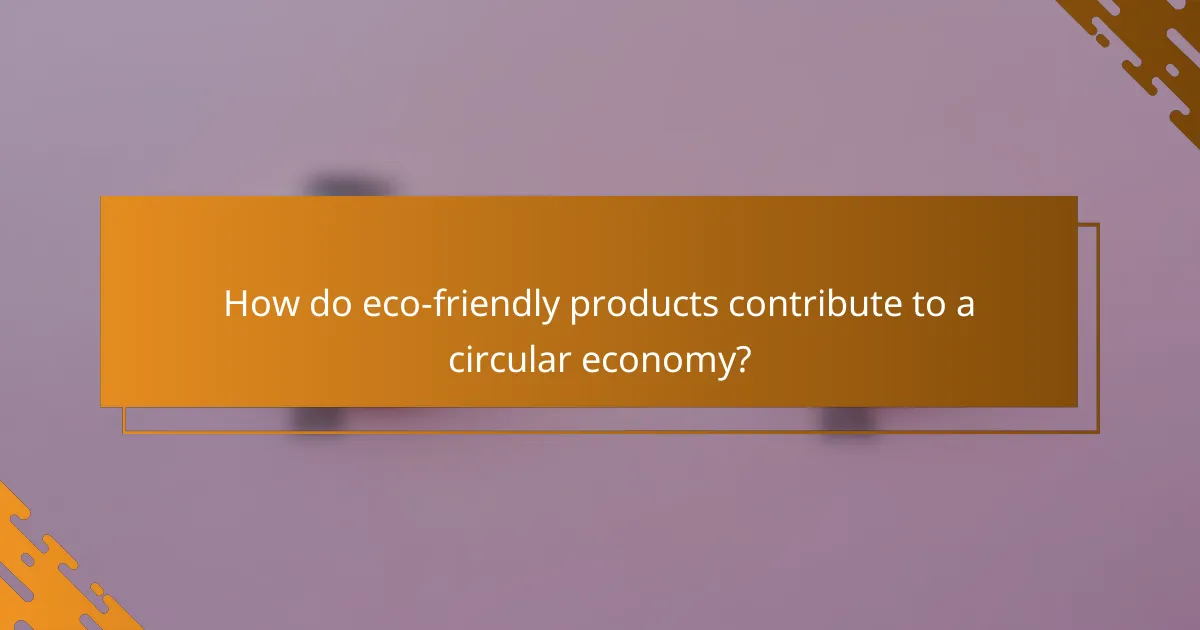
How do eco-friendly products contribute to a circular economy?
Eco-friendly products play a vital role in a circular economy by minimizing waste and maximizing resource use. They are designed to be reused, recycled, or composted, which helps reduce environmental impact and promotes sustainability.
Reduction of waste
The reduction of waste is a key principle of the circular economy. Eco-friendly products are often made from materials that can be easily recycled or repurposed, which helps divert waste from landfills. For instance, packaging made from biodegradable materials can break down naturally, reducing the volume of waste generated.
Additionally, companies can adopt strategies like take-back programs, where consumers return used products for recycling or refurbishment. This not only cuts down on waste but also encourages responsible consumption.
Resource efficiency
Resource efficiency refers to the optimal use of materials and energy in the production of goods. Eco-friendly products are typically designed to use fewer resources during their lifecycle, which can lead to significant savings. For example, products made from recycled materials require less energy to produce than those made from virgin resources.
By focusing on resource efficiency, businesses can lower their operational costs while contributing to environmental sustainability. Implementing practices such as lean manufacturing and sustainable sourcing can further enhance resource efficiency.
Extended product lifecycle
Extending the product lifecycle is essential for reducing environmental impact. Eco-friendly products are often built to last longer, which means they need to be replaced less frequently. This durability not only benefits consumers by providing better value but also reduces the overall demand for new resources.
Moreover, companies can design products with modular components that can be easily repaired or upgraded. This approach encourages consumers to maintain and use products longer, aligning with the principles of a circular economy.
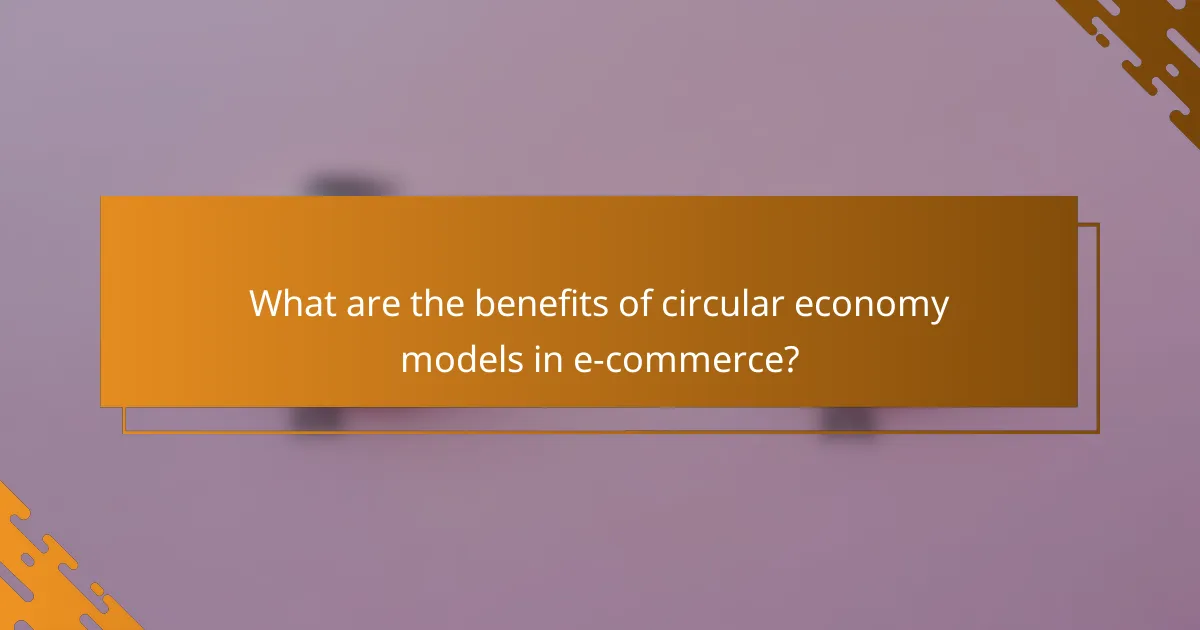
What are the benefits of circular economy models in e-commerce?
Circular economy models in e-commerce provide numerous advantages, including reduced waste and enhanced resource efficiency. By focusing on reusing materials and products, businesses can lower costs and improve sustainability while appealing to environmentally conscious consumers.
Cost savings for businesses
Circular economy models can lead to significant cost savings for e-commerce businesses by minimizing waste and optimizing resource use. Companies can reduce expenses related to raw materials, disposal, and energy consumption through practices like recycling and refurbishing products.
For example, businesses that implement take-back programs for used products can recover valuable materials, which can be reintegrated into production processes. This not only cuts costs but also helps stabilize supply chains by reducing dependency on new materials.
Increased customer loyalty
Implementing circular economy principles can enhance customer loyalty as consumers increasingly prefer brands that prioritize sustainability. By promoting eco-friendly practices, businesses can attract and retain customers who value responsible consumption.
Offering incentives such as discounts for returning used products or loyalty points for sustainable purchases can further encourage repeat business. This approach fosters a community of environmentally aware customers who are likely to advocate for the brand.
Positive brand image
A commitment to circular economy models can significantly improve a brand’s image in the marketplace. Companies that actively engage in sustainable practices are often viewed as more trustworthy and responsible, which can differentiate them from competitors.
Effective marketing of these initiatives, such as transparent reporting on sustainability efforts or certifications, can enhance brand perception. Consumers are more inclined to support brands that align with their values, leading to increased market share and profitability.
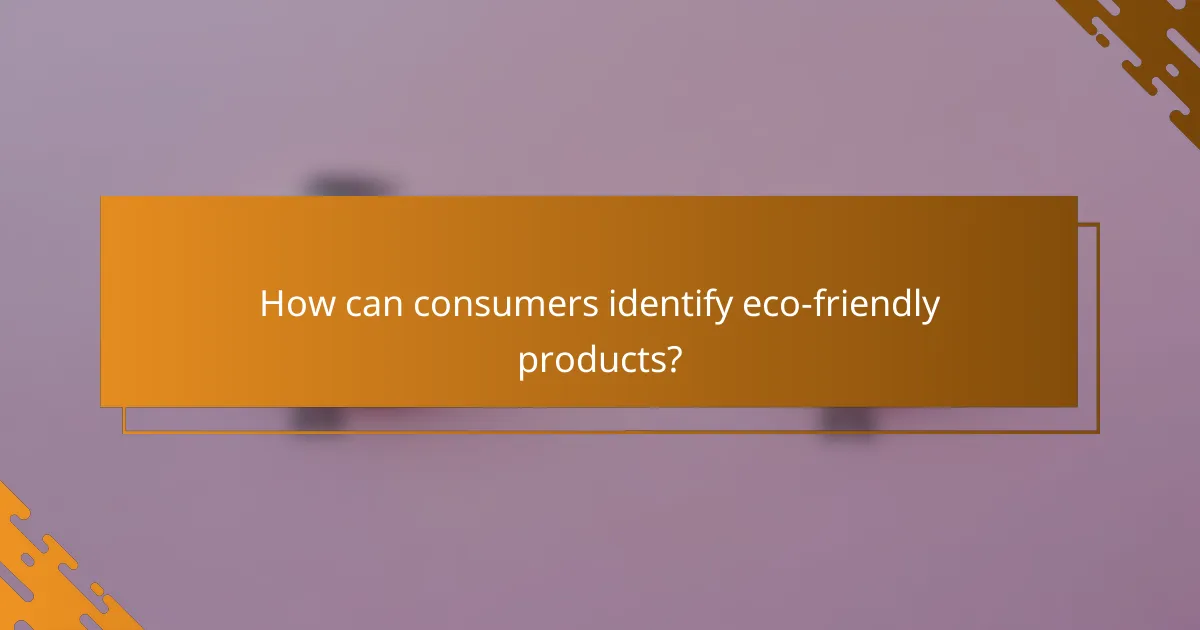
How can consumers identify eco-friendly products?
Consumers can identify eco-friendly products by looking for specific indicators such as certification labels, material transparency, and brand sustainability practices. These elements help ensure that the products are made with environmentally friendly processes and materials.
Certification labels
Certification labels are a key way to identify eco-friendly products. Look for recognized certifications like Energy Star, USDA Organic, or Fair Trade, which indicate adherence to environmental and social standards. These labels often require rigorous testing and compliance with specific criteria.
When shopping, check for labels that are relevant to your region, as different countries have their own certifications. For example, in the European Union, the EU Ecolabel signifies products that meet high environmental standards.
Material transparency
Material transparency refers to the clarity brands provide about the ingredients and materials used in their products. Eco-friendly products often disclose sourcing information, allowing consumers to understand the environmental impact of the materials. Look for brands that provide detailed information on their websites or product packaging.
Consider products made from recycled, biodegradable, or sustainably sourced materials. For instance, items made from bamboo or recycled plastics typically have a lower environmental footprint compared to conventional materials.
Brand sustainability practices
Evaluating a brand’s sustainability practices can help consumers make informed choices. Brands committed to sustainability often engage in practices such as reducing waste, using renewable energy, and implementing ethical labor practices. Researching a brand’s mission statement and sustainability reports can provide insight into their environmental commitment.
Be wary of greenwashing, where brands falsely claim to be eco-friendly. Look for transparency in their practices and third-party endorsements to ensure their claims are credible. Checking customer reviews and independent assessments can also help gauge a brand’s true sustainability efforts.
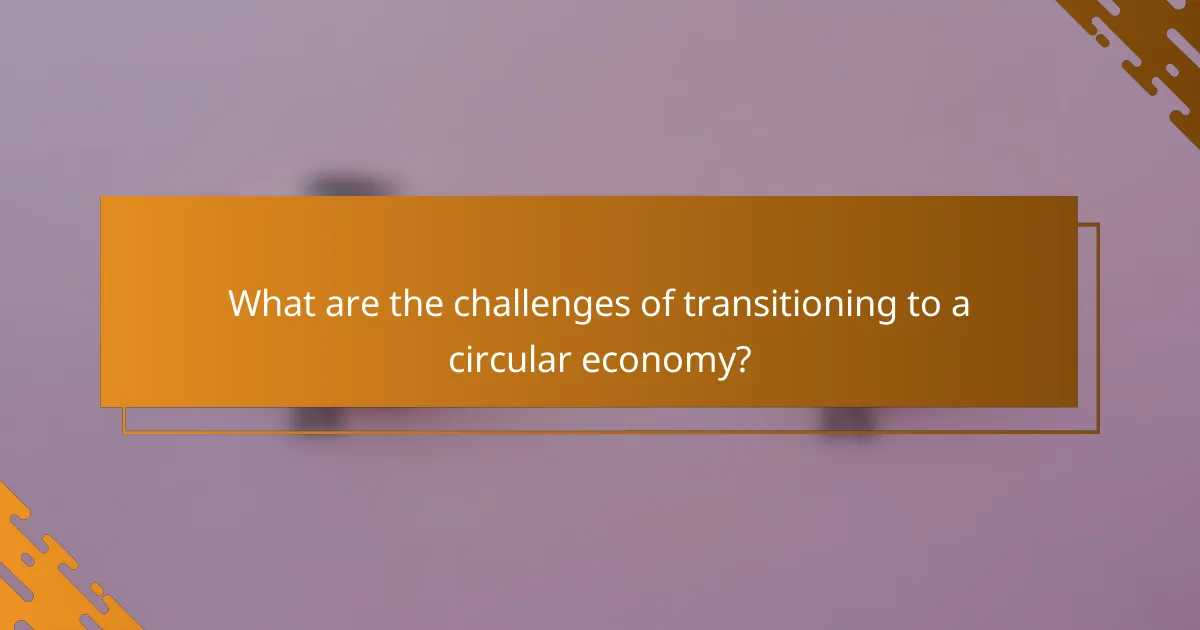
What are the challenges of transitioning to a circular economy?
Transitioning to a circular economy presents several challenges, including complex supply chains, varying levels of consumer awareness, and regulatory hurdles. Addressing these issues is crucial for businesses aiming to adopt sustainable practices effectively.
Supply chain complexity
The shift to a circular economy often complicates supply chains due to the need for new materials and processes. Businesses must establish relationships with suppliers who can provide recycled or sustainably sourced materials, which may not be readily available. This can lead to increased costs and longer lead times.
Moreover, companies must rethink logistics to accommodate reverse supply chains, where products are returned for recycling or repurposing. This requires investment in infrastructure and technology to track materials throughout their lifecycle.
Consumer awareness
Consumer awareness plays a significant role in the success of circular economy initiatives. Many consumers are still unfamiliar with the benefits of circular products, which can hinder demand. Companies need to invest in education and marketing to inform customers about the advantages of choosing sustainable options.
Engaging consumers through transparent communication about product origins and lifecycle impacts can foster loyalty and drive sales. Brands that effectively convey their commitment to sustainability often see a positive response from environmentally conscious consumers.
Regulatory hurdles
Regulatory hurdles can impede the transition to a circular economy, as existing laws may not support innovative recycling or reuse practices. Companies must navigate a complex landscape of regulations that can vary significantly by region, affecting their ability to implement circular strategies.
Staying compliant with environmental regulations, such as waste management laws, requires ongoing monitoring and adaptation. Businesses should actively participate in policy discussions to advocate for supportive regulations that facilitate circular economy practices.

How do linear and circular economy models differ?
Linear and circular economy models differ primarily in their approach to resource use and waste. The linear model follows a ‘take, make, dispose’ pattern, while the circular model emphasizes reusing and recycling materials to minimize waste and resource consumption.
Resource consumption patterns
In a linear economy, resources are extracted, used to create products, and ultimately discarded. This often leads to over-extraction and depletion of natural resources. In contrast, a circular economy aims to keep resources in use for as long as possible through practices like recycling, refurbishing, and sharing, thereby reducing the overall demand for new materials.
For example, in the circular model, companies may design products for durability and easy disassembly, allowing for parts to be reused or recycled. This approach not only conserves resources but can also lead to cost savings over time.
Waste management approaches
Waste management in a linear economy typically involves landfilling or incineration, which can result in significant environmental harm. In a circular economy, waste is viewed as a resource; strategies focus on reducing waste generation and promoting recycling and composting. This shift can significantly lower the environmental impact of waste disposal.
For instance, businesses adopting circular practices may implement take-back programs, encouraging consumers to return used products for recycling or refurbishment. This not only reduces waste but can also create a new revenue stream for companies.
Economic implications
The linear economy often leads to short-term profits at the expense of long-term sustainability, as it relies heavily on finite resources. Conversely, the circular economy can create new business opportunities and jobs by fostering innovation in sustainable practices and technologies.
Investing in circular economy initiatives may require upfront costs, but the long-term savings and benefits, such as reduced resource dependency and waste management costs, can outweigh these initial investments. Companies that embrace circular principles often find themselves better positioned in a market increasingly driven by sustainability concerns.

What role do governments play in promoting sustainability?
Governments play a crucial role in promoting sustainability by establishing regulations and frameworks that guide businesses and consumers towards eco-friendly practices. They create policies that encourage the adoption of sustainable technologies and practices, ensuring a collective effort towards environmental preservation.
Policy frameworks
Policy frameworks are essential for setting the groundwork for sustainability initiatives. Governments often develop legislation that mandates environmental standards, such as emissions limits or waste management protocols. For example, the European Union’s Green Deal aims to make Europe the first climate-neutral continent by 2050, influencing member states to adopt stringent environmental policies.
These frameworks can include guidelines for sustainable resource management, renewable energy usage, and conservation efforts. Local governments may implement zoning laws that favor green spaces and sustainable urban planning, which can significantly impact community sustainability efforts.
Incentives for businesses
Governments provide various incentives to encourage businesses to adopt sustainable practices. These can include tax breaks, grants, and subsidies for companies that invest in renewable energy or sustainable materials. For instance, in the United States, the Investment Tax Credit (ITC) offers significant tax reductions for solar energy investments, motivating businesses to transition to cleaner energy sources.
Additionally, governments may establish certification programs that recognize and reward sustainable practices, enhancing a company’s reputation and marketability. Businesses that participate in these programs often benefit from increased consumer trust and loyalty, which can lead to higher sales and profitability.
